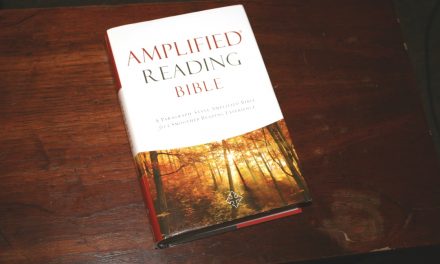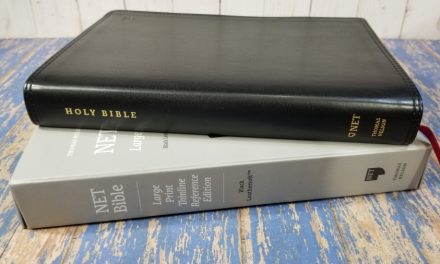
I love reading multiple translations of the Bible. I like seeing how translators with different backgrounds and educations bring ancient texts into modern languages. Often differences in translation give me insight into original meaning and strengthen my beliefs so I was interested in reading The New Living Message Bible. I knew it was at least part paraphrase (which should be thought of more as commentary than the Word of God) but I wanted to like it. Unfortunately I don’t.
The Holy Bible – New Living Message Version (NLMV) is marketed as “compassionate Scripture for the modern world” and as a “ground-breaking interpretive translation-paraphrase of the Holy Bible”. In my opinion it is modern and ground breaking at the cost of sound doctrine and important scriptures.
ISBN: 9781945905001
Evenpath Press provided this book free for review. I was not required to give a positive review, only an honest one. All opinions are my own.

They have named this “The Holy Bible” so we have included it in the Bible sections of our website thinking many would look for it there. Because of it’s interpretive paraphrasing and heavy redaction it doesn’t technically qualify as one.
The New Living Message Bible is available in paperback or digital formats. It is produced by Evenpath Press, the principal publisher for the Compassionate Faith Foundation. The paperback has a medium text and 502 pages of a thick paper that is commonly found in novels. The glued binding seems well put together. The text is laid out in a single column verse-by-verse format.

How do you fit the entire Bible in 502 pages? You don’t. This is not a complete Bible; of the Old Testament books only the first five are included and two books are missing from the New Testament. They have produced a companion volume called Kings and Prophets of the Old Testament if your “interests so dictate” that contains most of the rest of the Old Testament. You’ll have to get a real Bible if you want to read Amos, James, or Revelation.

The books that are included aren’t complete. They freely admit to having redacted many portions of the Bible. These were left out “not to diminish the historical or theological importance of specific portions” but to make what they considered “the essential texts and message more accessible for contemporary readers”. They have redacted lengthy descriptions, ritual practices and minor battles they feel bear little relevance to faith in the modern world, and things that conflict with “the evolving moral and ethical standards or our contemporary civilization.”

As far as I can tell they have removed many verses that they find difficult to explain or that doesn’t fit their theology. Peter’s entire message about the identity of Jesus Christ is missing from Acts 2 (as is any mention of speaking in tongues). The Jewish core tenet that “God is one” is missing from both Deuteronomy 6 and Mark 12. Many mentions of specific sins are also missing – Romans 1, 1 Peter 3, half the works of the flesh in Galatians 5 (by their numbering Galatians 6) as examples. Any they haven’t removed have been altered, some so far that they are barely recognizable as scripture. The entirety of Genesis 1 has been altered (both with omissions and additions) to give a much more evolutionary description of creation than the original texts would ever allow.
An important thing to note is that this text doesn’t use standard numbering for chapters and verses. Their reasoning is that standard numbering sometimes breaks narrative flow and allows “cherry picking” pieces of scripture to support ideas the text as a whole does not. They say reading the scriptures should be about knowledge and understanding not memorization and rote recitation. Other ways to help prevent these problems are leaving out the numbers entirely or presenting the text in paragraph format. The fact that renumbering helps hides how much is missing from those less familiar with the Bible was probably also a consideration.

If you are going to market a new translation you need to give your reader some basic information. Information that is for the most part missing about the NLMV, both in the book or on their website. They say this is an interpretive translation-paraphrase and that it falls on the dynamic end of the dynamic and formal equivalence spectrum. They don’t tell you the ratio of translation to paraphrase or that the paraphrased part isn’t dynamic because a paraphrase is by nature not equivalent. You don’t know the experience, education, or theological affiliation of the translators (or names). They state that they believe the Holy Bible is inspired by God. From the rest of the paragraph and some of the other introductory passages I don’t think they believe it is inerrant but all I can really do is guess when that fact should be plainly stated.
While they don’t discuss the underlying reasons for why they thought this translation was needed or any of their thought processes they do give you their purpose. The stated purpose of the NLMV was to “develop a new and vibrant English language version” that “demonstrates the relevance of God’s word to new generations living in the modern world”. They wanted to “reconcile where possible the language of scripture to the realities of our continuing discoveries in science, physics, mathematics, and cosmology” They hoped it would “convey God’s message of faith, healing and compassion to the modern world we actually live in.”

We at Bible Buying Guide believe the Bible is the inspired and inerrant Word of God. While I can commend and agree with the goal of revealing God and his Word in a relevant manner to our modern culture I believe this translation has fallen short of the mark. You aren’t reconciling scripture with science by eliminating what the Bible has to say on a subject and “science” or more accurately scientists don’t always know as much as they want you to believe. Our ethics and morality should be based on the Bible not the Bible’s message made to fit our modern ethics and morality.
The claims made about the norms of the original writers I find particularly disheartening. Animal sacrifice was an important part of the Jewish method of worship. But the rest of what they are claiming the Bible writers endorsed or sanctioned is false (human sacrifice, hatred of others for immutable characteristics, child abuse, profound discrimination of women, owning and selling of people). The Bible does tell you these things happened but does not condone them. The Bible is part history book and presents both the good and bad of the history it records. Any people using the Bible to support these practices have twisted or “cherry picked” to change the clear teachings of scripture. Something I’m afraid the editors and “translators” of this version are also guilty of.
This book, The New Living Message Bible, may have some use for helping word things in a more modern way or to help familiarize someone with no prior knowledge to the Bible. Paraphrases generally make good commentaries. So much has been changed or left out of this “Bible” however that I cannot truly recommend it for any of these purposes.
Photography by hannah C brown











“Compassionate Scripture for the Modern World”
That should tell you something about this “Bible” without even having to open it. Eliminating entire books, re-numbering verses, deleting verses? This is an evil creation.
The KJV only crowd is going to have a field day with this “bible translation”.
Wow. Smh. I’m very new to my faith and when I first seen this something didn’t seem quite right about it! “Compassionate scripture?” Really? I’m sorry I wouldn’t ever recommend this book to anyone and refer to it as a “Holy Bible!” Definitely agree with Pastor Keith’s comment, deleting verses and renumbering them? There’s nothing Holy about that! It’s a wolf in sheep’s clothing.
Brother Miguel, I’m glad to see that you were not deceived by this “Bible.”